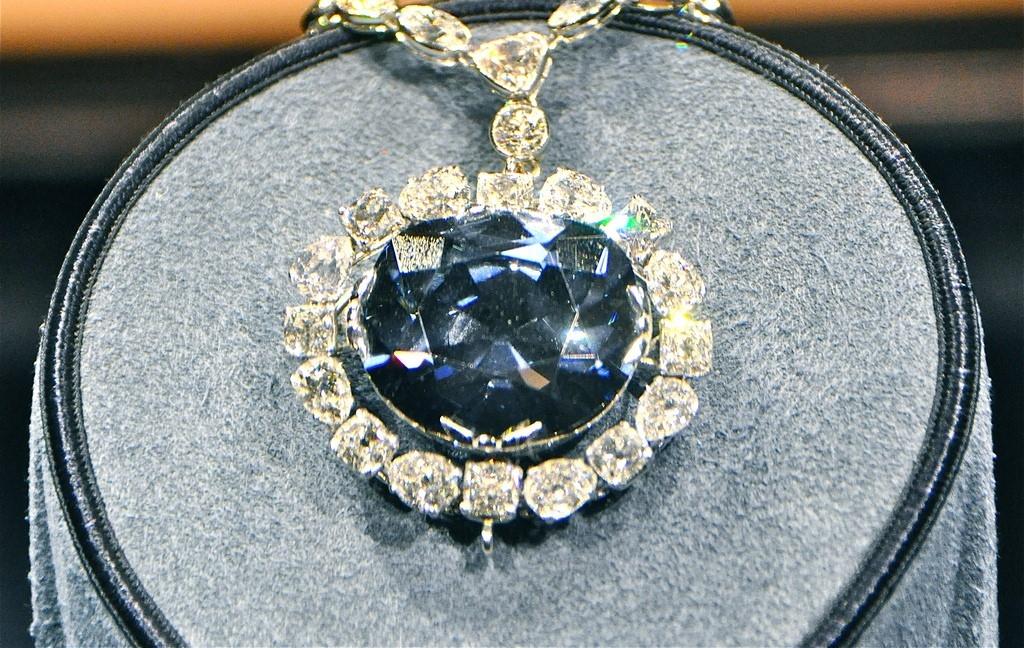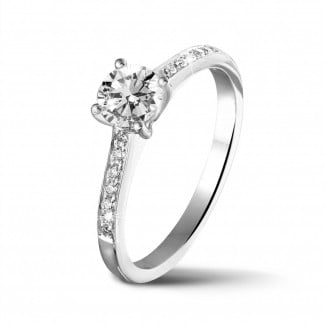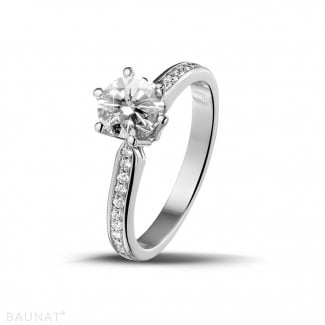Inspirational insights
Blogs in the spotlight
- How do I buy the perfect diamond ring?
- Choosing the perfect wedding ring
- Buying an engagement ring: expert tips & tricks
- Which earrings are the right ones for you?
- How to choose the perfect diamond bracelet?
- How to choose a necklace for ladies?
- Take your time in choosing your watch
- What's the right jewellery for each occasion?
- Why buy diamond jewellery online?
- A guide to building up your jewellery collection
- What types of precious metals are there?
- What types of precious metals are there?
- Jewellery trends and innovations in 2020
- What sorts of diamond setting are there?
Blue diamonds are extremely rare, but you might have already heard of the most famous blue diamond of them all: The Hope Diamond. We are delighted to share the whole story with you, including the unique history that goes with it. We are also excited to tell you all about a wonderful alternative to this coloured diamond, our hope diamond engagement ring. Find out more from the BAUNAT experts here.
Most viewed diamond jewels
The History of the Hope Diamond
Le Bleu de France was set into a chain which Louis XIV wore on state occasions

In 1988 it was confirmed that the Hope Diamond and Le Bleu de France are one and the same
The curse of the Hope Diamond
The Hope Diamond in recent history

What Makes the Hope Diamond So Special?
The Hope Diamond is classified as a Type IIb diamond. Barely 0.1% of all diamonds belong to this type
How Much Is the Hope Diamond Worth?
Where Can You See the Hope Diamond?

Our experts always work with the very best materials, too. We buy our diamonds and precious stones directly from the source. This means we are always assured of the best quality and we can save on price. Some jewellery is 30% to 50% cheaper at BAUNAT than at a physical jeweller.
Find Out More About Diamonds and Other Precious Stones
Frequently asked Questions
What is a sapphire?
A sapphire is a precious gemstone and a variety of the mineral corundum. They are commonly known for their striking blue colour, though other colour variations exist as well. A sapphire is the birthstone for the month September.
How expensive is a sapphire?
All through human history,sapphires were always especially sought after because of their unique beauty. The stones decorated the robes of nobles and the crowns of kings. Sapphires are not only divinely beautiful but also quite rare. They are often used as an alternative to ultra-expensive blue diamonds, although they are also valuable themselves. The colour and size ultimately determine what is paid for a specific sapphire.
What kinds of sapphire are there?
The most beautiful sapphires of the highest quality have a superb sky-blue colour. The blue sapphire is particularly popular with the aristocracy and royalty (see the British crown jewels!), and is often gladly set in wedding jewels as an accent colour. Hence, Kate Middelton received sapphire earrings as a wedding gift from the King of Saudi Arabia. The world's most valuable sapphire is the Blue Belle of Asia with a selling price of 17 million dollars!

Stephanie Hesters
- BAUNAT Antwerp
- My Linkedin profile - Contact me
 Design collections
Design collections Stackable Rings
Stackable Rings Ruby, sapphire & emerald
Ruby, sapphire & emerald Bestsellers
Bestsellers New arrivals
New arrivals Watches
Watches Cufflinks
Cufflinks Rings for men
Rings for men Diamond
Diamond Sapphire
Sapphire Ruby
Ruby Emerald
Emerald Yellow diamond
Yellow diamond Black diamond
Black diamond
 Diamond rings
Diamond rings Sapphire rings
Sapphire rings Ruby rings
Ruby rings Emerald rings
Emerald rings Yellow diamond rings
Yellow diamond rings Black diamond rings
Black diamond rings
 Stackable rings
Stackable rings Cocktail rings
Cocktail rings Rings for men
Rings for men Bestsellers
Bestsellers Diamond rings
Diamond rings Sapphire rings
Sapphire rings Ruby rings
Ruby rings Emerald rings
Emerald rings Yellow diamond rings
Yellow diamond rings Black diamond rings
Black diamond rings
 Solitaire
Solitaire Dangle
Dangle Diamond earrings
Diamond earrings Sapphire earrings
Sapphire earrings Yellow diamond earrings
Yellow diamond earrings Black diamond earrings
Black diamond earrings
 Solitaire
Solitaire 3 stones
3 stones Halo
Halo Gradient
Gradient Diamond necklaces
Diamond necklaces Sapphire necklaces
Sapphire necklaces Yellow diamond necklaces
Yellow diamond necklaces Black diamond necklaces
Black diamond necklaces
 Gradient
Gradient White gold
White gold Yellow gold
Yellow gold Red gold
Red gold Platinum
Platinum Diamond bracelets
Diamond bracelets Yellow diamond bracelets
Yellow diamond bracelets Black diamond bracelets
Black diamond bracelets
 View watches
View watches View watches
View watches Swiss Made
Swiss Made Swiss Collection limited edition
Swiss Collection limited edition Manufacturing process
Manufacturing process Manual or Automatic watch
Manual or Automatic watch Sapphire or mineral glass
Sapphire or mineral glass
 Rings
Rings Necklaces
Necklaces Bracelets
Bracelets Sapphire
Sapphire
 Engagement rings
Engagement rings Earrings
Earrings Necklaces
Necklaces Bracelets
Bracelets

















